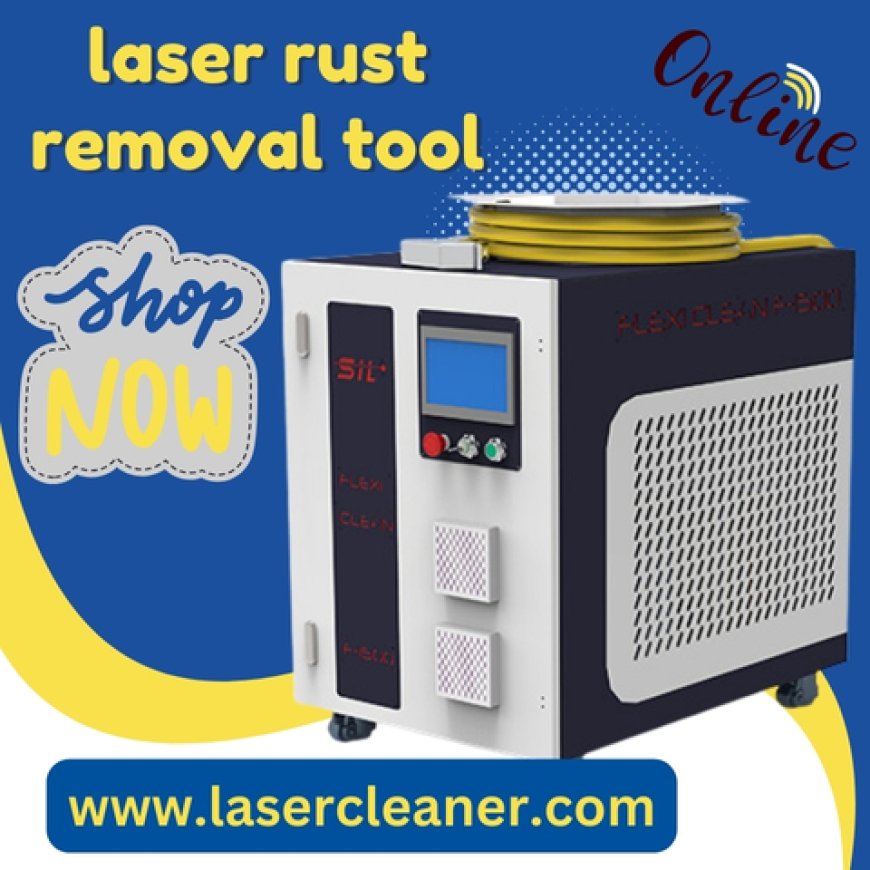Laser Rust Removal Tool: The Ultimate Rust Eraser for Precision-Critical Surfaces
Rust is the persistent enemy of every metal surface. Whether it's industrial machinery, antique car parts, ship hulls, or tools from your grandfather’s garage, rust has a way of clinging and corroding relentlessly. Over time, it compromises not only the aesthetics of the metal but its structural integrity as well. But here’s the catch—removing rust has never been a simple task. That’s exactly where the laser rust removal tool enters with quiet but precise confidence.

In this article, were diving deep into what makes this tool not just effective but essential for industries and individuals who deal with metal regularly.
What Exactly Is a Laser Rust Removal Tool?
Lets start with the fundamentals. A laser rust removal tool is a handheld or automated device that uses laser pulses to clean rust, paint, oxides, or other surface contaminants from metal. It works through a process known as laser ablation, where short, high-energy bursts of light hit the rust layer, vaporize it, and leave the clean metal beneath untouched.
Unlike traditional grinding or chemical methods, this tool doesnt use abrasives or solvents. It uses lightcontrolled, focused, and precisely tuned to strip away only the undesired layer. You dont scrub. You dont soak. You dont risk damaging the material underneath. You simply point, adjust, and let the laser do the rest.
Why Its Turning Heads Across Multiple Industries
This isnt some niche innovation meant only for laboratories. The laser rust removal tool is already being used across a wide range of industries including automotive restoration, aviation, maritime, energy infrastructure, defense, and even art restoration. But why?
Because metal isnt just metalits part of a machine, a structure, or a system that demands exact tolerances. When rust eats into a component or when abrasive cleaning methods leave scratches, its not just a cosmetic problem. It becomes a threat to performance and safety.
For example, in the aerospace industry, every part must conform to tight tolerances. A single scratch from sandblasting can lead to structural weaknesses over time. In pipeline maintenance, removing corrosion without thinning the pipe walls is critical. In heritage restoration, keeping the original metal intact while cleaning decades or centuries of oxidation is an art in itself. In all these situations, laser rust removal has become a non-negotiable solution.
How It Works (Without Getting Too Technical)
You might wonderhow can a laser be gentle and aggressive at the same time?
Heres the key: the laser rust removal tool is calibrated to a specific wavelength and pulse duration. These pulses are absorbed by the rust, not the metal. When rust absorbs this light, it heats up rapidly and is instantly vaporized or blown away by micro-explosions at the molecular level.
Meanwhile, the metal reflects the laser light and stays cool and untouched. Think of it like a surgeons scalpel compared to a lumberjacks axe. Youre not attacking the whole areayoure targeting only the infection.
The result is a clean, rust-free surface with no secondary waste, no abrasive residue, and no thermal damage. Its dry, contactless, and incredibly precise.
Common Applications Where It Shines (Literally)
-
Automotive Workshops:
Restoring a classic car? Removing surface rust from engine parts? The tool makes it easy to clean hard-to-reach areas without disassembly or rework. -
Maritime Sector:
Ships and boats constantly face corrosion due to saltwater exposure. Laser rust removal offers efficient deck and hull maintenance, extending the lifespan of marine assets. -
Factories and Plants:
Maintenance of industrial equipment becomes easier when you can remove rust and oxidation without dismantling the entire unit. Plus, no chemicals or dust means no mess. -
Construction and Infrastructure:
Steel beams, bridges, rebarany rusted structure that needs on-site cleaning can benefit from this tool. Fast setup and remote operation make it ideal for field work. -
Military and Aerospace:
Equipment reliability is critical here. Laser-based cleaning ensures components are service-ready without surface weakening. -
Historic Restoration:
Preserving metal sculptures, antique weapons, or historic machinery? This method cleans while retaining originalitysomething sandblasting could never promise.
The Business Edge of Owning One
In todays competitive service landscape, speed, precision, and clean operation arent perkstheyre necessities. A laser rust removal tool is not just a machineits a business differentiator.
Service providers using this technology can:
-
Complete jobs faster without compromising quality.
-
Charge premium rates for clean, residue-free results.
-
Serve high-end markets like aviation or heritage restoration.
-
Reduce waste disposal costs, as there are no abrasives or chemicals.
The upfront investment in a laser rust removal tool often pays itself back quickly due to operational efficiency and reduced labor hours. No downtime, no waiting for solvents to soak, and no masking or post-cleanup.
What to Consider Before Getting One
Before jumping in, its crucial to assess your cleaning needs. Do you handle large, flat surfaces or detailed, intricate parts? Is mobility important? What kind of power source do you have access to? These questions help determine if you need a portable, backpack-style unit, a desktop model, or an integrated robotic system.
Also, consider pulse power and beam widththese affect cleaning speed and accuracy. Choosing the right system makes all the difference in results and ease of use.
And remember, the operator doesnt need a science degreebut proper safety training is essential. Even though these lasers are controlled, theyre powerful tools. Safety goggles, controlled environments, and proper ventilation are mandatory during operation.
Final Thoughts
The laser rust removal tool isnt just another cleaning gadgetits the technological leap metal maintenance has long awaited. For too long, industries have relied on outdated, damaging, or wasteful rust removal methods. But now, the combination of precision, safety, and efficiency has changed the game.
Whether youre a restorer preserving legacy, a technician ensuring equipment reliability, or a business owner trying to scale up high-quality service offeringsthis tool delivers uncompromised results.
Rust will always exist, but now, we finally have a method that removes it without a trace, without a mess, and without regret. The future of rust removal doesnt grind or scrapeit shines with the power of light.









































